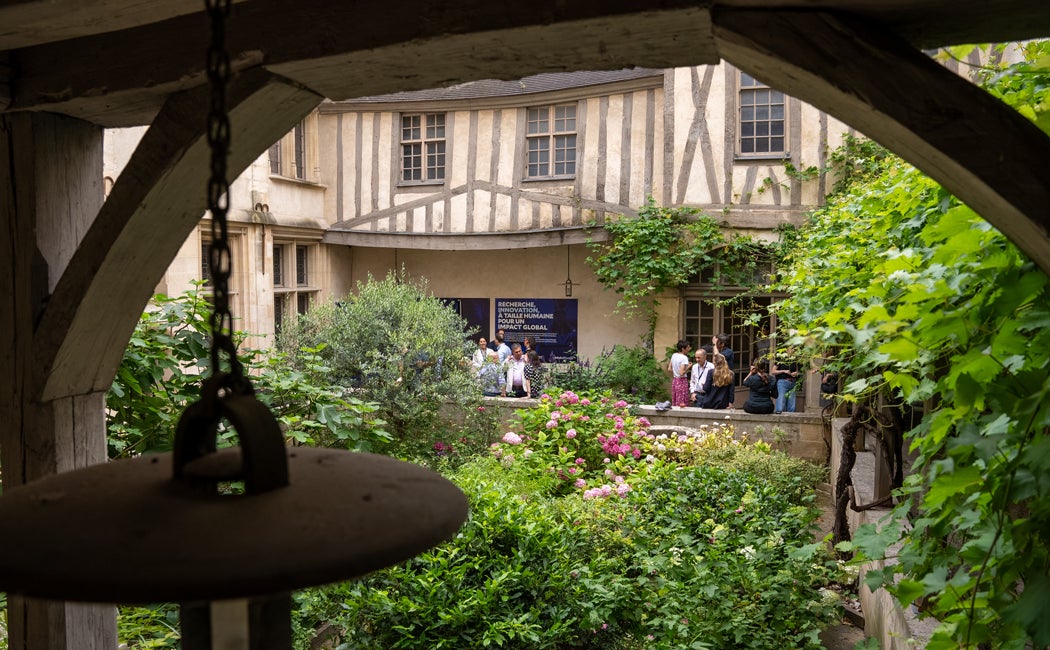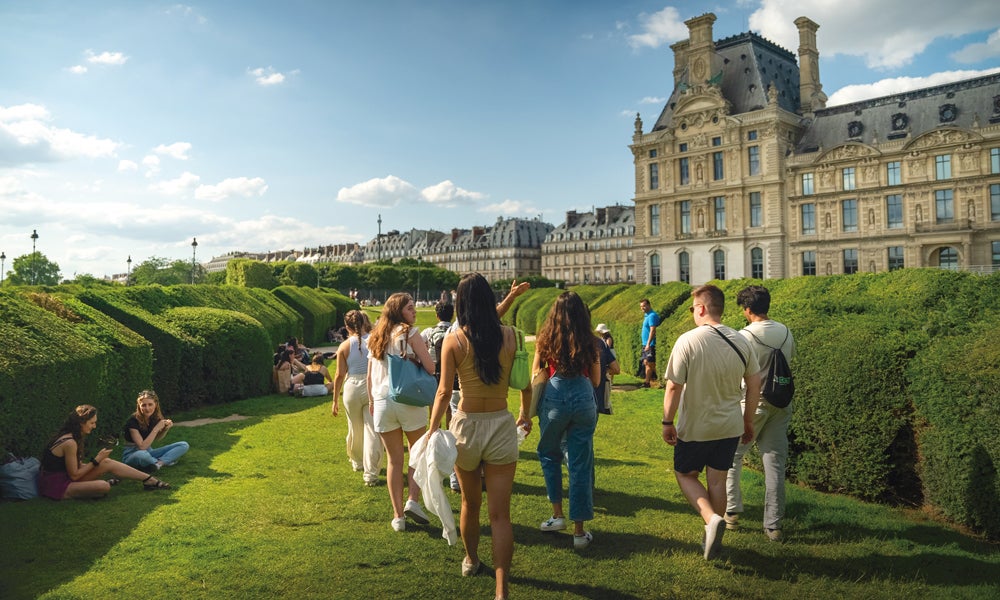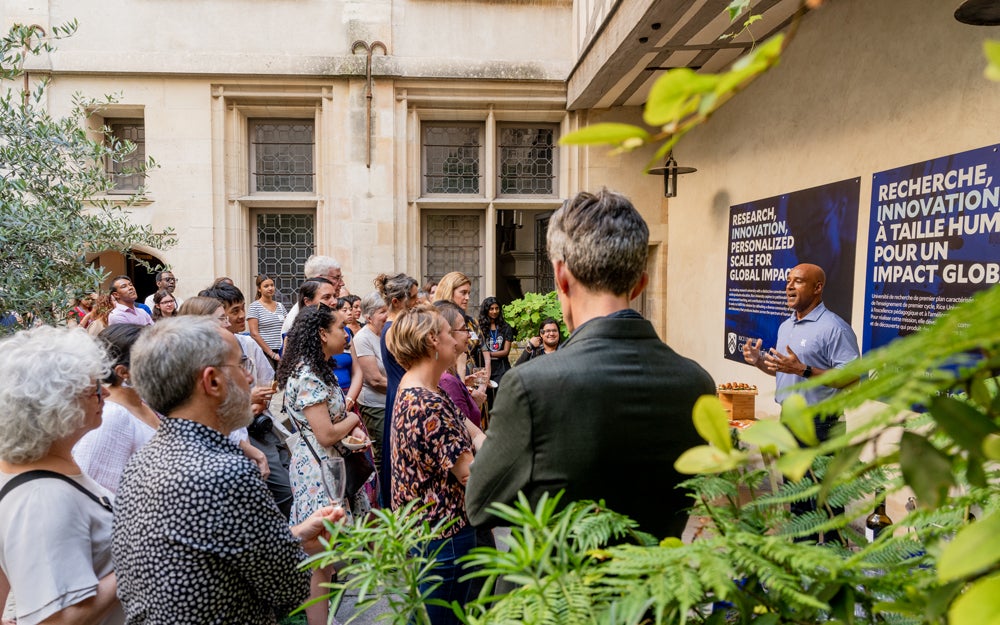City of Learning
Building on the success of the long-established Rice School of Architecture Paris, the university launched Rice Global Paris.

Fall 2025
By Robyn Ross
Paris is Europe’s intellectual center of gravity: it’s a city dense with political, artistic, literary and religious history, home to cutting-edge scientific research facilities and universities hundreds of years old. It’s the ideal place for Rice Global to make its international debut. Building on the success of the long-established Rice School of Architecture Paris, the university established the Rice Global Paris Center in 2022, a beautiful space in one of the city’s oldest neighborhoods that hosts classes and academic gatherings. Being in Paris “puts us at the epicenter of energy in our industry,” says Caroline Levander ’95, vice president for global strategy. The following pages offer a glimpse of Rice’s strategic engagement in Europe’s capital of culture.
The City as Classroom
For three years, the Rice Global Paris Center has hosted summer courses for undergraduates. Unlike traditional study abroad, in which students transfer credits from an overseas university, these programs are managed entirely by Rice: the three-week courses are taught in English by Rice faculty, the price of tuition includes housing and a Metro card, and students can use financial aid. Such arrangements make international education accessible for more students, and over four sessions this past summer, 200 Owls took a dozen courses in anthropology, neuroscience, Black American performance and even the chemistry of cooking.
“One of our philosophies for hosting courses in Paris is to take advantage of the city,” says Meredith Bonner, director of operations for Rice Global. “Whenever possible, we encourage faculty to think about using the city as part of their classroom.”
The dozen students enrolled in Romanticism: Ruins, Race, Revolution, taught this June by English professor Alexander Regier, used the city as their classroom virtually every day. Regier describes romanticism as both a concept that informs literary and artistic movements and the historical period from roughly 1750 to 1850. That century saw the American, French and Haitian revolutions; the advent of the abolition movement and the end of slavery in France; and elevation of the role of the individual, human rights, beauty and the natural world.

Regier has taught the course in Houston but says the class is entirely different in Paris: seeing a painting or visiting a building in person reveals far more than reading about it. Early on, the students visited the opulent royal palace of Versailles, an object lesson in the power and wealth imbalances that helped spark the French Revolution of 1789.
“Being there, you’re literally, physically overwhelmed by the space,” Regier says. “The relation between power and the representations of power in buildings — there’s an extra dimension to it that you cannot replicate in the classroom.”
Walking through room after gilded room, Isabella Regan ’27 craned her neck to take in the palace’s lavishly painted ceilings. “The first thing I said is, ‘I have never felt this minuscule in my life,’” she remembers. “And Dr. Regier said, ‘That is the point. You are meant to feel this small. You are not important in comparison to the power that these people had.’”
The class later visited the Pantheon, constructed in the late 1700s as a church but repurposed during the Revolution as a secular memorial to significant figures in French history. Monuments have been added — and sometimes deleted — up to the present, provoking questions about which people are honored and why.
The excursion “challenged us to think about how France constructed its rhetoric,” says Mia Baumann ’26. “We talked about how many people were added to the Pantheon posthumously and then removed, depending on how the society’s values changed. You can see how there’s a certain portion of society that curates how they want to be viewed by others and how their citizens interact with their history.”
As an Indian American woman attending a traditional Texas high school, Antara Varma ’28 often perceived the Western canon as something she was obligated to study but that felt tangential to her own life. She longed to learn about race, colonization and revolutions but didn’t have the chance until Regier’s class. In Paris, she developed a genuine curiosity about the ideas of Jean-Jacques Rousseau, Voltaire and Edmund Burke and their influence on present-day France.
“The most special part of this Paris experience is that it taught me not only the material, but why I should care about the material,” Varma says. “I got to see it not as something I just have to know so I can get a literature degree, but as something that is in conversation with the country as it is right now.”

What’s Nearby
The Paris Center is a stone’s throw from famous attractions in the City of Light, among them Notre-Dame Cathedral, Sainte-Chapelle, the Seine River, the Musée Picasso Paris, Maison de Victor Hugo, and the Shakespeare and Company bookstore, once frequented by F. Scott Fitzgerald and Ernest Hemingway.
A Central Location
Rice’s Paris location is, like its Houston flagship, in the center of the city and near significant research and education institutions. The building is tucked in Le Marais, a historic neighborhood in one of the most central arrondissements in the city. The district was excluded from many of the changes that remade Paris in the 19th century, preserving “a very ancient and in some places medieval street fabric, which makes it fascinating to explore,” says center administrative director Garry White. “It’s quite a condensed neighborhood, but it’s the kind of place you can get lost in, even if you’re familiar with it — in a nice way.”
Up to 50 students, faculty and conference guests can stay in single-occupancy apartments in five townhouses Rice has leased in the Butte-aux-Cailles neighborhood in the 13th arrondissement. The residential area is a half hour from the Paris Center via Metro. Thriving Asian restaurants and grocery stores here are a product of waves of Vietnamese immigration in the 1970s.
Living in one district and attending class in another “introduces the students to how many identities are present in Paris and how different each neighborhood is,” says Camille Evans, Paris Center program coordinator.

A City of Collaboration
To ensure Rice is a participant in the most significant academic conversations globally, the university is creating partnerships with the top institutions in France. “It’s just the highest density of world-class faculty,” says Caroline Levander, who forged the agreements. The first such arrangement is with Paris Sciences and Letters, a 15-year-old “super university” consortium of 11 smaller but much older higher education institutions. Levander is now establishing similar connections with Paris-Saclay and Sorbonne University. She says the French institutions want to build international research programs and are eager to work with Rice and, by extension, the leading medical, energy and technology institutions of Houston.
Rice and PSL jointly fund faculty from their respective institutions to develop research collaborations. In early summer, quantum scientist Junichiro Kono, who heads the Smalley-Curl Institute at Rice, spent a month in Paris collaborating with Carlo Sirtori, his counterpart at École Normale Supérieure, part of PSL. The two work at the frontier of an emerging subfield of quantum physics called solid-state cavity quantum electrodynamics (the study of how light confined in a reflective cavity interacts with matter). They had met at conferences but had never spent extended time together.
Kono stayed in one of the apartments Rice leases in Butte-aux-Cailles. Every morning, he went for a run, either in the vast Parc Montsouris or along the Seine, before taking the Metro a short distance to École Normale Supérieure. Kono spent the first half of the day in Sirtori’s office, talking through equations and ideas with Sirtori and his students. In the afternoons, Kono visited other researchers’ labs and offices, and he ended most days at one of Paris’ many jazz clubs.
In addition to touring the Rice Global Paris Center, he visited colleagues at the universities of Toulouse and Montpellier in southern France, Johannes Gutenberg University Mainz, and the University of Konstanz in Germany. Kono emerged from his month in Paris with several projects to pursue with Sirtori and many connections within and beyond École Normale Supérieure.
Even in the Zoom era, he says, there’s no substitute for meeting colleagues in person — at their labs or at a café on a summer evening for a glass of beer or wine. “That kind of thing is very important for science.”
The Paris Center and Rice’s partnership with PSL have enabled biogeochemist Caroline Masiello to collaborate with Samuel Abiven, a professor of terrestrial biogeochemistry at PSL member institution École Normale Supérieure. Abiven directs CEREEP-Ecotron, a one-of-a-kind field station for ecological research located roughly an hour from the city.
At the field station, researchers can conduct controlled experiments in both terrestrial and aquatic facilities at increasing environmental complexity. At the intermediate level of complexity, CEREEP has 22 “ecotrons”: large chambers similar to greenhouses that allow scientists to set temperature, rainfall and atmospheric gas composition. By using the ecotrons in conjunction with the field station’s laboratory facilities, researchers can study ecological processes at any scale between individual organisms and entire ecosystems.
One overarching goal in climate science research is to understand the relationship between processes that unfold at the cellular or molecular level and changes at the ecosystem scale, Masiello says. But it’s difficult to isolate biological processes to understand which ones are most influenced by climatic changes and which have the greatest impact on larger ecosystems. “The advantage of a place like CEREEP is it gives you the opportunity to do experiments at the molecular or genetic level, and also carry those experiments all the way through to the ecosystem level,” Masiello says. She and graduate student Julia Seay visited the field station last year, and Seay has begun a collaboration with Abiven’s group as part of her thesis.

Inside Info: Global Paris Center
Conferences and classes meet in the Leebron Room, named for Rice’s former president David Leebron, who opened the center. Guests marvel at the carved and painted ceilings, a feature common to private mansions in the 16th century but rare to find in excellent condition.
The basement level includes two rooms with barrel-vaulted stone ceilings. Such rooms were once used to store grain or wine, as they stay cool in the summer and warm in the winter. Today they host meetings, classes and film screenings.
Seating in the garden surrounds a central enclosure for plants and a dry well. A grapevine-covered arbor along one wall provides shelter and shade.

All About Food
Summer students cook in their apartments or dine out; many restaurants offer breakfast and lunch specials or student deals. In the fall, occasional group meals will be provided, but students can cook in their apartments and use restaurant vouchers, a dining system that is well established in France. Camille Evans, the center program coordinator, shared favorite spots in the neighborhood, including Hanoi Street, a Vietnamese café with a 9€ lunch; Panozzi, offering Italian sub sandwiches; and l’As du Falafel, one of many falafel spots in the Marais — historically the city’s Jewish quarter — but it might be the best. Mia Baumann, who recently wrapped up a summer class at the Rice Global Paris Center, recommends the combos or “Formule Midi” from La Charrette à Crêpes, where they offer a sweet and savory crepe and a drink at a discount. “The flavors are somewhat unexpected, but the combination was incredible.”

An Urban Oasis
The Rice Global Paris Center is a former grand townhouse, or mansion, called the Hôtel de La Faye. Built in the 1540s, it was renovated and restored in the late 1990s. The center sits behind a separate residential building that fronts the street; visitors enter via an unassuming door in the front building and walk through a passageway into a courtyard, where they find the entrance to the Paris Center. The building encloses a peaceful and elegant garden completely hidden from the street. Both Houstonians and Parisians who have seen it all are charmed and amazed by the space, says Garry White. “The location is fantastic, it’s so pleasant to walk around the area, and you’re so central to cafés and bars, ice cream and cultural opportunities all within walking distance. But when you enter, you’re actually withdrawing from the city into a very intimate and private space.”
A City of Conversations
Paris is an accessible, appealing destination for scholars from around the world, and Rice-convened gatherings in the city elevate the university’s international profile. The Paris Center generates “opportunities for collaboration with all of Europe, and access to and proximity to some of the best researchers in the world,” says Meredith Bonner.
In fall 2024, the Paris Center hosted the inaugural symposium on the Art and Science of Total Synthesis of Natural and Designed Molecules for Biology and Medicine. The event convened many of the world’s top experts in synthetic organic chemistry, including K.C. Nicolaou, the Harry C. and Olga K. Wiess Professor of Chemistry at Rice, whose pioneering research has contributed to the development of cancer treatments; Ben Feringa, a Dutch chemist who won the 2016 Nobel Prize in chemistry; and Morten Meldal, a Danish professor who won the 2022 Nobel Prize in chemistry. The symposium “not only celebrated the achievements of leading chemists but also explored the future of total synthesis in addressing global challenges in medicine and beyond,” said Angel Martí, who chairs Rice’s Department of Chemistry.

In April, the Paris Center hosted The Brain Economy: Empowering Minds, Transforming Economies, an executive education program of the James A. Baker III Policy Leadership Program. The event brought together researchers in neuroscience and leaders in both startups and major corporations, such as Shell. Participants learned about the brain economy, a framework for developing economic strategies that prioritizes the cultivation of cognitive, emotional and social skills, and the prevention of dementia and other neurodegenerative disorders.
Europe is leading the conversation about the brain economy, says program director Victoria Jupp, but the work is accelerating in Texas with the spring 2025 passage of the Dementia Prevention Research Institute of Texas, which, if approved by voters in November, will significantly expand brain-health research. Meeting in Paris made the event accessible to participants from around the world and allowed the group to tour the Paris Brain Institute, France’s leading neuroscience research center and a Rice partner.
Also in April, a dozen top scholars in religious pluralism attended New Directions for Global Research on Religious Pluralism and Violence, convened by the Boniuk Institute for the Study and Advancement of Religious Tolerance. The Paris Center served as a “third place,” a neutral ground where academics of all nationalities felt comfortable meeting to share ideas, says Elaine Howard Ecklund, director of the Boniuk Institute. Participants included scholars who were ethnically Israeli and Palestinian and researchers from Ukraine and Singapore. “The Rice Global Paris Center provided a place for really top-notch academic diplomacy, in the sense that the academy is able to bring together people who wouldn’t in political contexts even be able to interact,” she says.
Continuing the Conversation
In September, a dozen delegates from the Rice Neuroengineering Initiative and the Texas Medical Center will meet counterparts from the Paris Brain Institute for a joint symposium on Translational Neurotechnologies. Rice neuroengineering and the Paris Brain Institute have a natural synergy, says Rice’s Behnaam Aazhang, director of the initiative. “What we bring to the table is our engineering and our translational view of this space, and they are the scientists. This symposium is to find common ground to actually develop projects.”
Semester of Sciences
For the first time this fall, the Paris Center will host undergraduates for a semester. The program is designed with students in the life sciences and health professions in mind, whose highly structured curriculum typically doesn’t allow the flexibility to study abroad. Rice faculty in Paris will teach cell biology and biochemistry — two courses in the pre-health sequence — as well as courses in psychology and French language and culture that fulfill social sciences and humanities requirements. On tap are guest lectures from researchers at Paris Science and Letters and excursions to the Museum of Psychiatry and Neuroscience, the History of Medicine Museum, and the lab of Pierre and Marie Curie. The experience can enhance the students’ applications to health-professions schools, says Rice bioscientist Edward Nikonowicz, department chair and professor of biosciences in the Wiess School of Natural Sciences. “Medical schools are looking for people who have experiences outside the classroom,” he says. “This program allows students to learn in the context of a different culture, contributing to a broadening of their life experience.”
